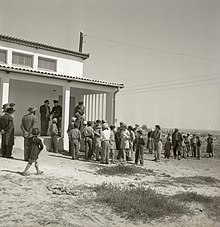Shafrir synagogue shooting attack
| Shafrir synagogue shooting attack | |
|---|---|
| Part of Palestinian Fedayeen insurgency | |
 Kfar Chabad shortly after the mass shooting | |

The attack site | |
| Location | Kfar Chabad, Israel |
| Date | 11 April 1956 |
Attack type | Shooting |
| Deaths | 6 |
| Injured | 5 |
The Shafrir synagogue shooting attack was an attack which was carried out by Palestinian terrorists on 11 April 1956.[1] Three Palestinian militants who crossed into Israel from Egypt attacked the study hall of a synagogue while it was full of children and teenagers, in the farming community of Kfar Chabad (Shafrir).[2][3][4] Six people, five children and a youth worker, were killed.
Attack[]
A Palestinian Arab fedayeen squad entered Israel from Egypt. They came to the village of Kfar Chabad (Shafrir) during the evening of 11 April 1956, which at the time was mainly inhabited by refugees from the Soviet Union.[3] One waited by the escape vehicle, another cut the electricity to the synagogue, plunging the interior into darkness, and the third entered the synagogue and fired into the crowd of 46 children aged 9–16 inside at the time. Five boys[5] and their 24-year old instructor Simcha Zilberstrom were killed.[6][7] Five children were injured, three of them in serious condition.[6] One teacher named Yeshayahu Gopin threw children out the window during the shooting, saving several lives.[8][9] A group of village men gathered firearms kept in a small defense locker and rushed to the school, arriving about five minutes after the attack began, but by that time, the shooting had stopped and the perpetrators had made their escape. The police were called with the village's only telephone, and the only two vehicles in the village were used to take the wounded to the nearby Tzrifin Medical Center.[7]

Aftermath[]
Following the attack, the traumatized villagers began to seriously consider abandoning the settlement. The Lubavitcher Rebbe, Rabbi Menachem Mendel Schneerson, was consulted and responded that they should remain and continue to build.[9][10]
The incident shocked the Israeli public. Newspapers reported on the attack and the despondent national mood in its aftermath for days. Herzl Rosenblum wrote in Yediot Ahronoth that "Entering the school's modest synagogue was like visiting Kishinev after the pogrom of 50 years ago." The day following the attack, Israeli Foreign Minister Moshe Sharett sent an urgent message to United Nations Secretary-General Dag Hammarskjöld informing him on the latest fedayeen raids and highlighting the attack on Kfar Chabad. Speaking to delegates of the United Nations Security Council, Israel's United Nations ambassador Abba Eban condemned the "murder of Israeli children and their instructor in the sacred moment of prayer." At the end of the traditional thirty-day mourning period for the victims, thousands of people from across Israel attended the cornerstone laying ceremony for a new vocational school in the village, including numerous political figures and Israel's two chief rabbis.[7]
References[]
- ^ Morris, Benny (25 May 2011). Righteous Victims: A History of the Zionist-Arab Conflict, 1881-1998. Knopf Doubleday Publishing Group. ISBN 978-0-307-78805-4.
- ^ "Kentucky New Era - Google News Archive Search".
- ^ a b "The tragedy in Israel: The correct response". blogs.timesofisrael.com. Retrieved 11 February 2022.
- ^ Chesler, Phyllis (11 January 2005). The New Anti-Semitism: The Current Crisis and What We Must Do About It. Wiley. p. 50. ISBN 978-0-7879-7803-7.
- ^ Silverman, Yair. "To Life!". Times of Israel. Retrieved 11 February 2022.
- ^ a b Bar-On, Mordechai (2012). Moshe Dayan: Israel's Controversial Hero. Yale University Press.
- ^ a b c Margolin, Dovid (4 December 2017). "Murder on a Moonless Night: How the Rebbe Responded to Terror in Israel". chabad.org. Retrieved 11 February 2022.
- ^ "The tragedy in Israel: The correct response". blogs.timesofisrael.com. Retrieved 11 February 2022.
- ^ a b https://www.chabad.org/library/article_cdo/aid/1765/jewish/The-Rebbe-Who-Saved-a-Village.htm
- ^ "The shiva trap: To say or not to say?". blogs.timesofisrael.com. Retrieved 11 February 2022.
External links[]
- Israel Says Arabs Made Night Attack - published on Star-News on 11 April 1956
- 1956 in Israel
- Mass murder in 1956
- Terrorist attacks attributed to Palestinian militant groups
- Palestinian Fedayeen insurgency
- Murdered Israeli children
- 20th-century attacks on synagogues and Jewish communal organizations
- 1956 crimes in Israel
- Terrorist incidents in Asia in 1956
- Terrorist incidents in Israel in the 1950s
- 1956 murders in Asia
- 1950s murders in Israel
- Terrorist incidents in Israel
- School shootings in Asia